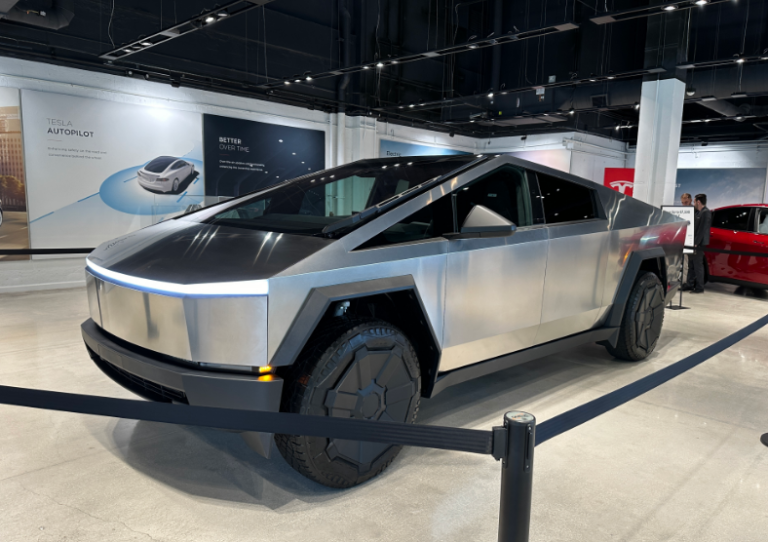In the dynamic realm of automobiles, Tesla’s Cybertruck has emerged as a captivating blend of futuristic design and dazzling performance. Recently undergoing crucial crash tests, a pivotal step in gauging the safety of this road behemoth, the Cybertruck has garnered as much intrigue as concern.
The Cybertruck in Action: Impressive yet Alarming
Picture a vehicle aiming to merge the robustness of a tank with the elegance of modern art. Elon Musk’s latest creation, the Cybertruck, has demonstrated its ability to compete with sports cars in terms of traction and acceleration. However, questions arise about its safety. A recent DPCcars video showcasing a crash test between the Cybertruck and a 2023 Dodge RAM 1500 reveals a striking outcome. While the RAM deforms to absorb the impact, the Cybertruck remains nearly intact, thanks to its stainless steel exoskeleton. This innovative technology, however, raises safety concerns.
Concerns Surrounding Cybertruck’s Design and Safety
The Cybertruck’s unique design draws parallels with the iconic 1981 DeLorean, but this design choice may have serious implications in the event of a collision. Experts, including former Insurance Institute for Highway Safety president Adrian Lund, express concerns. The robust exoskeleton, according to them, could exacerbate injuries in an impact.
Elon Musk asserts that the Cybertruck’s stainless steel panels are designed to absorb shocks. Nevertheless, tests reveal a troubling trend: insufficient deformation during collisions. This lack of energy absorption, as noted by automotive safety expert Samer Hamdar, could increase risks for pedestrians and cyclists.
The Cybertruck: Regulatory Challenges in Europe
Tailored for vast American roads, the Cybertruck appears ill-suited for European conditions. Stringent EU regulations, prohibiting vehicles with protruding edges, present a major obstacle to the Cybertruck’s market entry in Europe. Even Tesla’s Chief Engineer, Lars Moravy, acknowledges these challenges.
The European Council for Transport Safety has already expressed reservations, citing the Cybertruck’s considerable power and weight. While these features are enticing, they potentially heighten dangers in a collision. However, the prospect of Tesla abandoning the European market seems unlikely. It is more plausible that the company will adapt the Cybertruck’s design to meet European requirements.
The Tesla Cybertruck: Technological Feat or Regulatory Puzzle?
Tesla’s Cybertruck undeniably showcases technological prowess but poses a puzzle concerning safety and regulatory compliance. Its commercial success and ability to instill confidence in these aspects will be decisive for its future on the roads, particularly in Europe. Whether customers will embrace this modern titan remains to be seen.
Crash-Test Alarms and European Roadblocks
Elon Musk’s ambitious Cybertruck may face more than just safety concerns. European regulations, particularly those governing pedestrian safety, pose a significant barrier. The Cybertruck’s sharp lines and edges violate the EU’s minimum body curvature standards of 3.2 millimeters. Lars Moravy’s acknowledgment that achieving this curvature on a 1.4-millimeter stainless steel sheet is impossible raises questions about the vehicle’s viability in Europe.
Moreover, the Cybertruck’s rigid structure, while minimizing deformation in collisions, raises issues during crash tests. European standards require deformable zones at the front and rear to absorb kinetic energy and reduce the impact on occupants. The Cybertruck’s failure to meet these standards challenges its entry into the European market.
European Sales Hurdles for the Cybertruck
While the Cybertruck has made its mark in the U.S., its journey to European roads appears fraught with challenges. The vehicle’s weight exceeding 3.6 tons requires a commercial driver’s license in many European countries. Tesla’s decision to halt reservations outside North America and the subsequent surge in demand indicate potential delays for European customers. The need for a lighter version or European homologation as a Class C1 truck remains uncertain.
Despite its unprecedented popularity, the Cybertruck’s European future hangs in the balance. Whether Tesla can navigate the regulatory maze and reshape the Cybertruck for European roads remains uncertain. While the Cybertruck may not conquer European streets, its global appeal and success elsewhere may be sufficient to secure its place as a modern marvel – if customers can endure the wait.




















0 Comments